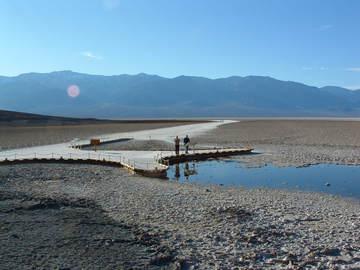Badwater Basin is located in the southern part of California's Death Valley National Park. Almost everybody who takes the trouble to visit the place knows that Badwater is the lowest elevation in the Northern Hemisphere (at 282 feet below sea level), and that it is extremely arid, hot, and mantled with vast salt flats. However, until recently nobody knew that Badwater Basin is also home to a microbe that may hold the key to important advances in biotechnology and nanotechnology.
An article in a recent issue of Science (23 December 2011: Vol. 334 no. 6063 pp. 1720-1723) reported that a team of scientists conducting National Science Foundation-supported research in Death Valley discovered a previously unreported species of magnetotactic bacteria living in the brackish water of a Badwater spring.
The research project is a team effort with international input. Dennis Bazylinski (University of Nevada Las Vegas ) and Christopher Lefèvre (French National Center of Scientific Research and University of Aix-Marseille II) teamed up to collect the samples at Badwater. Other project members include David Pignol (French National Center of Scientific Research and University of Aix-Marseille II), Nicolas Menguy (Pierre and Marie Curie University, France), Fernanda Abreu and Ulysses Lins (Federal University of Rio de Janeiro, Brazil), Mihaly Pósfai (University of Pannonia, Hungary), Tanya Prozorov (Ames Laboratory, Iowa), and Richard Frankel (California Polytechnic State University, San Luis Obispo).
Magnetotactic bacteria, which are found in nearly all water bodies, are one-celled organisms containing nanocrystals of magnetite (Fe3O4) or greigite (Fe3S4). These exceedingly tiny magnetic crystals, called magnetosomes, cause the bacteria to align with the earth's geomagnetic field. They consequently swim in either a north-seeking or south-seeking manner.
The ability of magnetotactic bacteria to orient in this way is part of nature's elegant design. Their miniature "compass needles" help these oxygen-avoiding bacteria know which way is down. Down is the direction they must go to find the deeper, less oxygenated water they prefer. Since the field lines extending to geomagnetic north are downward-angled in the Northern Hemisphere (because they are highest at the equator), bacteria in the Northern Hemisphere need to be north-seeking in order to swim toward deeper water. In the Southern Hemisphere, where the field lines extending to geomagnetic north are upward-angled, the bacteria need to be south-seeking.
There are important practical applications of magnetotactic bacteria. Because these natural magnets are smaller and better than the ones humans can manufacture, they can be used in various procedures and processes that require exceedingly small magnets. Medical imagery and drug delivery are just two of the technologies that benefit from this.
The microbe recently discovered in Death Valley's Badwater Basin is a greigite-producing magnetotactic bacterium representing a previously unknown group of sulfate-reducing (compound sulfur "breathing") bacteria in the Deltaproteobacteria class. It has been labeled strain BW-1.
BW-1 is unusual in that it has two sets of magnetosome genes and is able to biomineralize both greigite and magnetite, depending on environmental conditions. Other magnetotactic bacteria known to science have just one set of magnetosome genes and can produce only one mineral -- either magnetite or greigite. This is pretty strong evidence that separate sets of genes control the biomineralization processes.
Time will tell, but it seems likely that the ability of BW-1 to produce both magnetite and greigite might prove very important for the mass production of the two minerals.




Comments
It is not an elegant design. It is a mechanism derived from evolutionary processes.
Uh, for the record, I do believe in evolution.
seems pretty elegant to me!!!
Evolution is an elegant design.
But there, in a couple of comments, lies one of the most serious problems facing us today. When we allow tiny differences like a choice of words to get in the way of human communication, we defeat our ability to reason together. When we are unable to reason together, we lose the ability to cooperate. When we can't -- or are unwilling -- to cooperate, we are unable to solve problems facing all of us.
So are our deadlocked politicians products of evolution, elegant design, or devolution?
Product of heading down an unsustainable direction with little character involved.